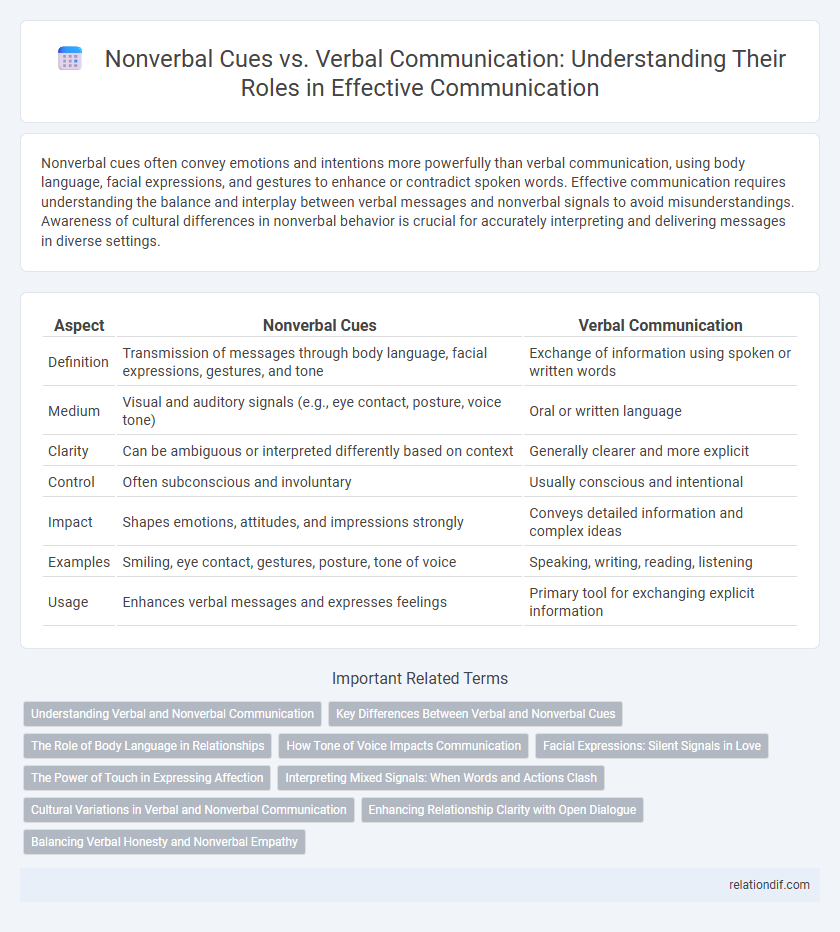Nonverbal cues often convey emotions and intentions more powerfully than verbal communication, using body language, facial expressions, and gestures to enhance or contradict spoken words. Effective communication requires understanding the balance and interplay between verbal messages and nonverbal signals to avoid misunderstandings. Awareness of cultural differences in nonverbal behavior is crucial for accurately interpreting and delivering messages in diverse settings.
Table of Comparison
| Aspect | Nonverbal Cues | Verbal Communication |
|---|---|---|
| Definition | Transmission of messages through body language, facial expressions, gestures, and tone | Exchange of information using spoken or written words |
| Medium | Visual and auditory signals (e.g., eye contact, posture, voice tone) | Oral or written language |
| Clarity | Can be ambiguous or interpreted differently based on context | Generally clearer and more explicit |
| Control | Often subconscious and involuntary | Usually conscious and intentional |
| Impact | Shapes emotions, attitudes, and impressions strongly | Conveys detailed information and complex ideas |
| Examples | Smiling, eye contact, gestures, posture, tone of voice | Speaking, writing, reading, listening |
| Usage | Enhances verbal messages and expresses feelings | Primary tool for exchanging explicit information |
Understanding Verbal and Nonverbal Communication
Nonverbal cues, including facial expressions, gestures, and body language, convey emotions and intentions that words alone may not fully express. Verbal communication relies on spoken or written language to deliver clear and precise information, but its effectiveness increases when combined with consistent nonverbal signals. Understanding both verbal and nonverbal communication enhances interpersonal connections and reduces misunderstandings in diverse social and professional contexts.
Key Differences Between Verbal and Nonverbal Cues
Nonverbal cues include facial expressions, gestures, posture, and eye contact, conveying emotions and attitudes often without words. Verbal communication relies on spoken or written language to express specific information and ideas clearly. Key differences lie in the former's emphasis on tone, body language, and context, while the latter depends on vocabulary, syntax, and articulation for precise message delivery.
The Role of Body Language in Relationships
Body language plays a crucial role in relationships by conveying emotions and intentions beyond words, often revealing true feelings through gestures, facial expressions, and posture. Nonverbal cues like eye contact, touch, and proximity can build trust and empathy, enhancing emotional connection between partners. Verbal communication is important, but body language often provides deeper insights into sincerity and emotional state, shaping relationship dynamics significantly.
How Tone of Voice Impacts Communication
Tone of voice significantly influences communication by conveying emotions and attitudes beyond the spoken words, such as confidence, sarcasm, or empathy. Nonverbal cues like pitch, volume, and intonation shape listeners' interpretations and engagement, often determining whether the message is perceived as sincere or hostile. Understanding the impact of tone of voice enhances clarity, reduces misunderstandings, and strengthens interpersonal connections in both personal and professional communication contexts.
Facial Expressions: Silent Signals in Love
Facial expressions serve as powerful nonverbal cues that convey emotions and intentions without spoken words, playing a crucial role in romantic communication. Subtle movements such as smiles, eye contact, and microexpressions express affection, attraction, and empathy, often revealing true feelings more honestly than verbal declarations. Recognizing these silent signals enhances emotional connection and deepens understanding between partners in intimate relationships.
The Power of Touch in Expressing Affection
Touch conveys affection through nonverbal cues such as hugs, handshakes, and gentle pats, often expressing emotions more deeply than words alone. Studies show that physical contact can release oxytocin, enhancing feelings of trust and bonding in relationships. Unlike verbal communication, touch transcends language barriers, making it a universal and powerful tool for emotional connection.
Interpreting Mixed Signals: When Words and Actions Clash
Nonverbal cues often convey emotions and intentions more accurately than verbal communication, especially when words and body language conflict. Interpreting mixed signals requires analyzing facial expressions, gestures, posture, and tone of voice to understand the true message behind the spoken words. Effective communication depends on aligning verbal messages with consistent nonverbal signals to avoid misunderstandings and build trust.
Cultural Variations in Verbal and Nonverbal Communication
Cultural variations significantly influence both nonverbal cues and verbal communication, affecting how messages are interpreted across different societies. For instance, gestures like eye contact or hand signals may convey respect in one culture but be considered rude in another, while tonal variations and language choice shape verbal interactions. Understanding these cultural nuances enhances cross-cultural communication effectiveness and reduces misunderstandings in global contexts.
Enhancing Relationship Clarity with Open Dialogue
Nonverbal cues such as body language, facial expressions, and eye contact significantly complement verbal communication by adding emotional depth and clarity. Open dialogue encourages expressing thoughts and feelings explicitly, reducing misunderstandings and strengthening trust between individuals. Combining intentional verbal expression with attentive observation of nonverbal signals enhances relationship clarity and fosters effective interpersonal connections.
Balancing Verbal Honesty and Nonverbal Empathy
Balancing verbal honesty and nonverbal empathy enhances effective communication by combining clear, truthful spoken messages with supportive body language such as eye contact and open gestures. Nonverbal cues like facial expressions and tone of voice often convey empathy and emotional understanding, complementing direct verbal honesty. Mastering this balance fosters trust, reduces misunderstandings, and strengthens interpersonal connections.
Nonverbal cues vs Verbal communication Infographic

 relationdif.com
relationdif.com